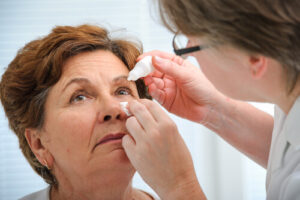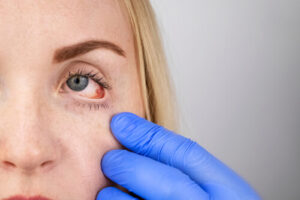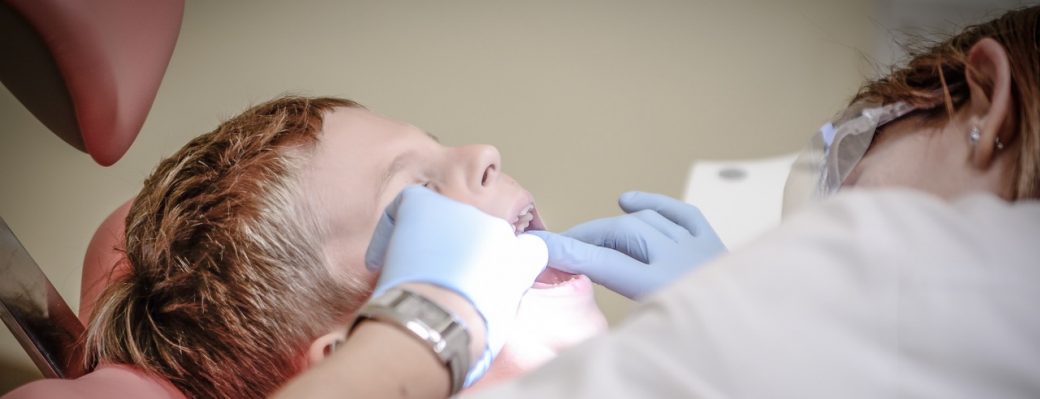Ofloxacin eye drops stand out as a pivotal treatment for bacterial eye infections. Tailored to combat a broad spectrum of bacteria, these drops offer hope for individuals suffering from uncomfortable and potentially vision-threatening conditions such as conjunctivitis and keratitis.
This article delves into the essential aspects of ofloxacin eye drops, covering their benefits, application techniques, and crucial safety information. Our goal in using this medicine is to provide a comprehensive overview that enlightens and empowers patients to navigate their treatment with confidence and informed insight.
Understanding Ofloxacin Eye Drops: What You Need to Know
Understanding ofloxacin eye drops is essential for anyone dealing with bacterial eye infections. These eye drops are a powerful ophthalmic solution to treat bacterial infections, including conjunctivitis and corneal ulcers. They work by inhibiting the DNA-gyrase in bacteria, which is crucial for bacterial replication and survival, thereby stopping the infection.
Bacterial Infections
Ofloxacin eye drops are specifically formulated to target and eliminate bacteria responsible for eye infections, making them effective for conditions like bacterial conjunctivitis and corneal ulcers.
Drug Interactions and Allergic Reactions
Patients should be aware of potential drug interactions and watch for any signs of unusual or allergic reactions. Informing your healthcare professional about your medical history and any other drugs you are taking is crucial.
Application
The correct application involves placing the drops in the affected eye and using techniques to avoid contamination, such as not touching the dropper tip to the eye or any other surface. After application, gently close the eye and apply gentle pressure to the inner corner to prevent the solution from draining.
Dosage and Missed Doses
Adherence to the prescribed dosage is important for the effectiveness of the treatment. If you miss a dose, skip the missed dose and continue with your regular dosing schedule unless your doctor advises otherwise.
Side Effects
While ofloxacin eye drops are generally well-tolerated, some users may experience transient ocular burning, blurred vision, or other mild side effects. Serious symptoms should prompt immediate medical attention.
Special Considerations
The medication is not recommended for use with soft contact lenses due to the presence of benzalkonium chloride, and its use in pediatric use, pregnant women, or breastfeeding mothers should be discussed with a health care professional.
The Benefits of Using Ofloxacin Eye Drops for Eye Infections
Ofloxacin eye drops are a formidable ally in the fight against eye infections, offering many benefits that underscore their effectiveness and reliability. This potent ophthalmic solution is designed to halt the growth of bacteria, thereby alleviating symptoms and promoting a swift recovery.
Broad-Spectrum Antibiotic: Ofloxacin eye drops are effective against many bacteria, making them a versatile treatment option for various bacterial eye infections.
Rapid Relief of Symptoms: Patients often experience a quick reduction in symptoms such as redness, itching, and discharge, contributing to improved comfort and quality of life.
High Efficacy: These eye drops have a high success rate in eradicating infections, reducing the risk of complications and the spread of infection to others.
Convenience and Ease of Use: The treatment regimen for ofloxacin eye drops is straightforward, allowing easy integration into daily routines without significant disruption.
Reduced Risk of Resistance: When used as directed, ofloxacin eye drops help minimize the risk of developing antibiotic resistance, ensuring the medication remains effective for future infections.
Safety Profile: Ofloxacin eye drops have a favorable safety profile, with minimal risk of systemic side effects due to their localized application.
How to Properly Apply Ofloxacin Eye Drops for Maximum Effectiveness

Ensuring the proper application of ofloxacin eye drops is crucial for maximizing their effectiveness in treating eye infections. By adhering to these guidelines, patients can enhance the therapeutic benefits of ofloxacin, accelerating recovery and reducing the risk of complications.
Wash Your Hands: Always thoroughly wash your hands with soap and water to eliminate contaminants that could be transferred to the eye or the eye drop container.
Check the Dropper Tip: Inspect the dropper tip to ensure it is not chipped or cracked, and verify that the solution is clear, not cloudy or discolored, indicating it is safe to use.
Lean Your Head Backward: Carefully lean your head backward and lower your bottom eyelid to form a tiny pouch for applying the drops.
Administer the Drops: Hold the dropper above the eye with the tip down. Look up and away from the dropper, and squeeze out the prescribed number of drops into the lower eyelid without letting the dropper touch your eye or eyelid to avoid contamination.
Close Your Eyes: After applying the drops, close your eyes for 1 to 2 minutes. Do not blink or rub your eyes, which can spread the medication away from the intended area.
Apply Gentle Pressure: To maximize absorption, press gently on the inner corner of your closed eye (near the bridge of your nose) for about one minute. This helps to keep the medication in the eye and reduces systemic absorption.
Wipe Excess Liquid: Use a clean tissue to gently wipe away any excess medication from around the eye, not inside the eyelid.
Wait Between Drops: If you are prescribed more than one drop or using other eye medications, wait 5 to 10 minutes before applying the next medication to ensure proper absorption.
Replace and Tighten Cap: Immediately recap the eye drop bottle after use to maintain sterility and prevent contamination.
Possible Side Effects and Precautions When Using Ofloxacin Eye Drops

When using ofloxacin eye drops, it’s imperative to be aware of potential side effects and necessary precautions to ensure safe and effective treatment of eye infections. Being informed about these possible reactions and taking appropriate precautions can significantly mitigate risks and enhance the treatment experience.
Understanding Possible Side Effects:
- Minor Side Effects: Commonly reported side effects include temporary discomfort, burning or stinging upon application, redness, itching, or blurred vision. These symptoms are usually mild and tend to resolve quickly.
- Serious Side Effects: Although rare, some individuals may experience severe reactions, such as intense or prolonged eye irritation, swelling, severe dizziness, or trouble breathing. Such symptoms require immediate medical attention.
- Allergic Reactions: Symptoms of an allergic reaction to Ofloxacin eye drops, including rashes, itching or swelling (particularly around the face, tongue, or throat), intense dizziness, or difficulties in breathing, require immediate medical attention.
Precautions for Safe Use:
- Medical History: Inform your doctor about your full medical history, including any other eye conditions or allergies, to ensure that ofloxacin is safe.
- Avoid Contamination: Do not touch the dropper tip to any surface, including the eye itself, to prevent contamination of the solution.
- Contact Lens Use: Patients should avoid wearing contact lenses unless advised by a doctor, as ofloxacin eye drops can interact with them or exacerbate existing infections.
- Pregnancy and Breastfeeding: Consult with your healthcare provider about the use of ofloxacin eye drops if you are pregnant or breastfeeding to understand any potential risks.
- Drug Interactions: Discuss any other medications or supplements you are taking with your healthcare provider to avoid adverse drug interactions.
Comparing Ofloxacin Eye Drops to Other Bacterial Eye Infection Treatments
Comparing ofloxacin eye drops to other treatments for bacterial eye infections highlights the importance of selecting the right medication based on the infection’s severity, the causative bacteria, and the patient’s specific needs. Understanding how ofloxacin stands compared to other treatments, only bacterial infections, can guide patients and healthcare providers in making informed decisions about eye care.
Spectrum of Activity: Ofloxacin eye drops cover many bacteria, including strains resistant to other antibiotics, offering a significant advantage in treating diverse bacterial eye infections.
Resistance Development: Compared to older antibiotics, ofloxacin has a lower risk of bacteria developing resistance, making it a potent option for difficult-to-treat infections.
Application Frequency: Ofloxacin often requires fewer daily applications than some other eye antibiotics, which can improve patient compliance and convenience.
Side Effect Profile: While generally well-tolerated, ofloxacin’s side effect profile is comparable to other antibiotics, with most adverse effects being mild and transient.
Cost and Accessibility: The cost and availability of ofloxacin can vary, with some newer or brand-name treatments being more expensive, potentially influencing treatment choice based on insurance coverage or budget constraints.
Storing and Handling Ofloxacin Eye Drops: Best Practices

Proper storing and handling of ofloxacin eye drops are essential to ensure their effectiveness and safety. This antibiotic ophthalmic solution, designed to treat bacterial eye infections, requires careful attention to storage instructions and handling techniques to maintain its potency and avoid contamination. Understanding and adhering to best practices for storage and handling can significantly impact the treatment outcomes for patients suffering from eye infections.
Storage Temperature: Ofloxacin eye drops should be stored at room temperature, away from light and moisture. It’s crucial to avoid storing them in locations subject to extreme temperatures, such as a car dashboard or near windows.
Keep the Cap Tightly Closed: To prevent contamination, ensure the bottle cap is tightly closed when not in use. Contamination can compromise the drops’ effectiveness and safety.
Avoid Touching the Dropper Tip: Direct contact between the dropper tip and any surface, including the eye or hands, can introduce bacteria into the solution. Always keep the dropper tip clean and avoid touching it.
Monitoring Expiry Dates: Regularly check the expiry date on the bottle. Expired eye drops may lose their effectiveness and should not be used. Dispose of expired or unused eye drops according to pharmacy guidelines or local regulations.
Following Prescription Guidelines: Use ofloxacin eye drops strictly as a healthcare professional prescribes. Do not share the drops with others, even if they have similar symptoms, to prevent the spread of infection or cross-contamination.
Understanding Storage After Opening: Some eye drops, including ofloxacin, may have specific storage instructions once the bottle is opened. Follow any additional guidelines the manufacturer or your healthcare provider provides regarding post-opening storage.
When to See a Doctor: Recognizing Signs of Complications
Recognizing when to see a doctor is crucial in effectively managing eye infection treatment, especially when using ofloxacin eye drops. While these drops are effective for bacterial infections, certain signs and symptoms may indicate complications that require professional medical intervention. Being vigilant to tell your doctor about these signs can help prevent the progression of the infection and safeguard your eye health.
Key Signs That Warrant a Doctor’s Visit:
- Worsening Symptoms: If symptoms such as redness, pain, or discharge from the eyes worsen or do not improve after a few days of treatment with ofloxacin eye drops, it’s important to seek the doctor for medical advice.
- Severe Allergic Reactions: Symptoms of a severe allergic reaction, including swelling of the face, lips, or eyelids, severe itching, or difficulty breathing, necessitate immediate medical attention.
- Vision Changes: Any significant changes in vision, such as blurred vision that does not resolve shortly after application or any loss of sight, should prompt a visit to the doctor.
- Signs of Infection Spreading: If signs suggest the infection is spreading, such as increased swelling around the eye or developing a fever, seeking medical advice is essential.
- No Improvement Within a Specified Time Frame: If there is no noticeable improvement within 48 to 72 hours after starting ofloxacin eye drops, a doctor may need to reassess the treatment plan.
In conclusion, ofloxacin eye drops are a highly effective solution for treating bacterial eye infections, offering rapid relief and preventing further complications. Their ability to target a wide range of bacteria makes them an invaluable tool in the eye care arsenal. Patients must adhere to the prescribed usage guidelines and consult their healthcare provider for any concerns to ensure the best possible outcomes. Whether dealing with an acute infection or managing a recurrent issue, ofloxacin eye drops can provide the healing support your eyes need. Remember, maintaining eye health is crucial, and with the right treatment, you can overcome infections and enjoy clear, comfortable vision.
References
Ofloxacin (Ophthalmic Route) – Mayo Clinic
https://www.mayoclinic.org/drugs./ofloxacin./drg-20065155?p=1
Ofloxacin Ophthalmic: MedlinePlus Drug Information
https://medlineplus.gov/druginfo/meds/a602029.html
Ofloxacin – Drugs and Lactation Database (LactMed®)
https://www.ncbi.nlm.nih.gov/books/NBK501055/
Ocuflox (ofloxacin ophthalmic) dosing, indications, interactions
https://reference.medscape.com/drug/ocuflox-ofloxacin-ophthalmic-343582
Ofloxacin Ophthalmic solution USP 0.3%
https://dailymed.nlm.nih.gov/dailymed/fda/fdaDrugXsl.cfm?setid=c76d8dc7-9a66-471b-814b-ef7f3605ec93


